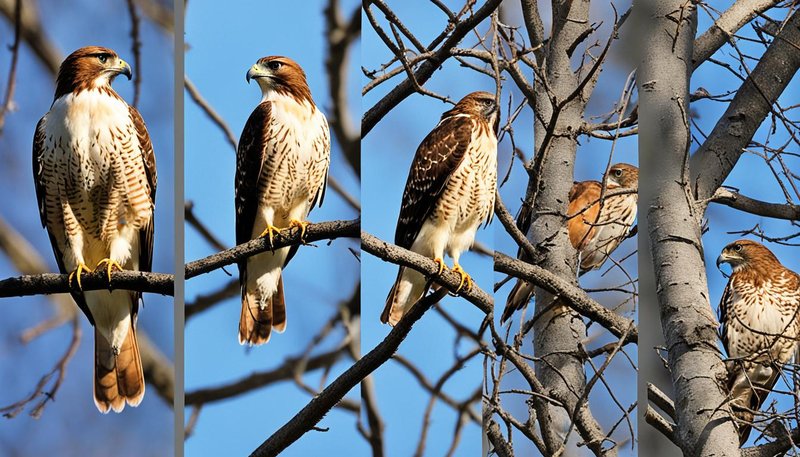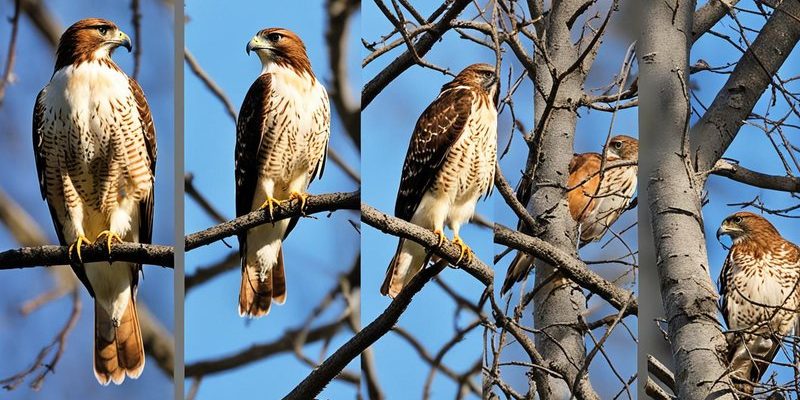
Imagine spotting a hawk perched on a branch, its sharp eyes surveying the landscape below. Isn’t it fascinating to think that with just a bit of knowledge, you could easily determine if it’s a red-tailed hawk? Let me walk you through the key features and behaviors that make these birds stand out among their feathered friends.
Recognizing the Distinctive Appearance
One of the first things you’ll notice about a red-tailed hawk is its stunning appearance. These birds are medium to large, typically ranging from 18 to 26 inches in length. They have a wingspan of about 3.3 to 4.8 feet, which gives them an impressive presence in the sky. Their body is robust, and they often appear larger when soaring due to their broad wings.
Coloration is another giveaway. Most red-tailed hawks have a brownish, mottled back and a lighter, speckled underside. But the real showstopper is their tail: it’s a rusty red that’s hard to miss when they fly. Think of it as a vibrant flag waving in the sky, helping you spot them from a distance.
Keep an eye out for color variations, too. While the classic red-tailed hawk is brown and red, some can exhibit lighter or darker plumage. Juveniles may have streaked bellies and more of a brown tail, so don’t get discouraged if they don’t look exactly like the adults.
Observing Flight Patterns
Flight patterns can say a lot about a hawk. Red-tailed hawks have a distinctive way of soaring that sets them apart from other birds. When you watch them, you’ll notice they often glide with their wings held flat, which gives them a graceful, almost effortless appearance.
You may wonder why this matters. Well, understanding their flight helps you identify them when they’re on the move. They can soar for long periods without flapping their wings too much, using thermal drafts. If you see a hawk soaring in circles, it’s likely a red-tailed hawk using the warm air rising from the ground to gain height.
Also, look for their flapping style. When they do flap, it’s methodical and steady, rather than rapid and frantic like smaller birds. This can help you distinguish them from other hawks or birds of prey.
Listening to Their Unique Calls
Of course, visual cues are vital, but did you know their vocalizations are also a great identifier? Red-tailed hawks have a distinctive call that sounds like a series of long, high-pitched screams. It’s really a classic “kreeee” sound, often associated with the wild and untamed nature.
Next time you’re outdoors, take a moment to listen. If you hear that familiar call echoing through trees, it’s likely a red-tailed hawk announcing its presence. This call isn’t just for show; it’s a means of communication, signaling territory and attracting mates.
You might be wondering how to differentiate their call from other birds. While many raptors have similar sounds, the red-tailed hawk’s call is unique in its length and pitch, making it easy to recognize once you’ve heard it a few times.
Understanding Their Habitat Preferences
The habitat of red-tailed hawks is another clue to identifying them. These birds are incredibly adaptable and can thrive in various environments. You’ll often find them in open fields, grasslands, and even along highways. They love areas with plenty of perches, like telephone poles or tree branches, from which they can spot prey.
If you’re walking through a park or driving down a rural road, keep an eye out for them perched high up. Their keen eyesight allows them to detect movement from a considerable distance, making them excellent hunters.
When scouting for red-tailed hawks, look for large, open areas. They’re less likely to thrive in dense forests where visibility is limited. So, if you’re exploring a mixed forest, you may want to look for edges or clearings where they might appear.
Spotting Their Hunting Behavior
Watching a red-tailed hawk hunt can be a thrilling experience. These birds are known for their hunting prowess, often preying on small mammals like rodents, rabbits, and even birds. It’s fascinating to see how they employ their sharp talons and strong beaks to catch prey.
When observing them, you might notice their methodical hunting style. They often hover or perch quietly, scanning the ground for movement. Once they spot a target, they swoop down with incredible speed and precision.
This hunting behavior can be a great indicator. If you see a hawk hovering in place or suddenly diving toward the ground, it’s likely a red-tailed hawk in action. It’s like watching a nature documentary unfold live right before your eyes!
Recognizing Other Hawks for Comparison
Sometimes, it can be helpful to compare red-tailed hawks to other similar species. For instance, the swainson’s hawk and the rough-legged hawk can be confused with the red-tailed hawk due to similar size and shape.
However, there are some differences to note. Swainson’s hawks have longer, more slender wings and are often lighter in color, especially when they’re in their breeding plumage. Rough-legged hawks, on the other hand, tend to have feathered legs and a more rounded tail, making them look different in flight.
By understanding these subtle differences, you’ll gain more confidence in your identification skills. It’s like being part of an exclusive club of birdwatchers who can spot the nuances of hawk behavior and appearance.
Putting It All Together: Tips for Identification
So, you’ve learned about their appearance, flight, calls, habitats, and hunting methods. Let’s wrap it all up with some handy tips for identifying red-tailed hawks in the wild:
- Look for the red tail: That rusty red color is a big clue.
- Observe their flight patterns: Gliding with wings flat is a classic red-tailed behavior.
- Listen for their calls: The long, high-pitched “kreeee” is their signature sound.
- Check their habitats: Look in open fields and high perches.
- Watch for hunting: Dive or hover behavior can indicate a red-tailed hawk on the hunt.
By keeping these points in mind, you’ll be well on your way to confidently identifying red-tailed hawks in the wild.
In conclusion, understanding how to identify a red-tailed hawk can make your outdoor experiences even more rewarding. Each observation opens a window into the fascinating world of these birds. So, grab your binoculars, head outside, and enjoy the thrill of spotting one of nature’s most majestic hunters! Happy birdwatching!

